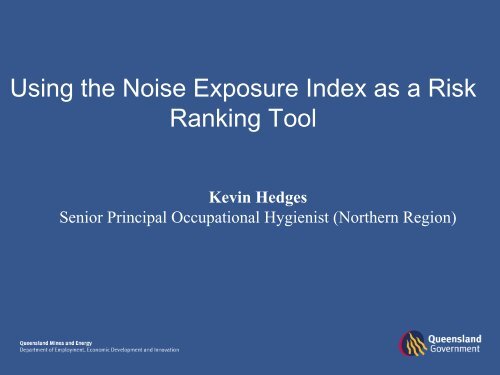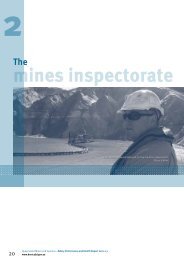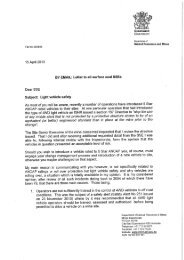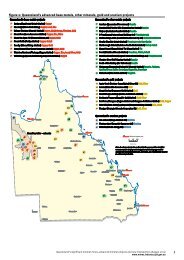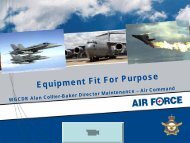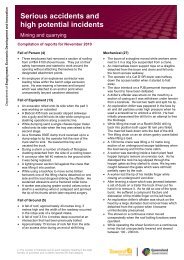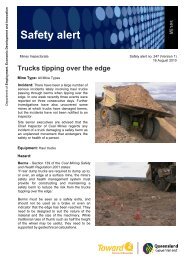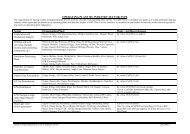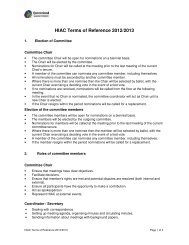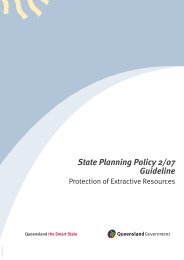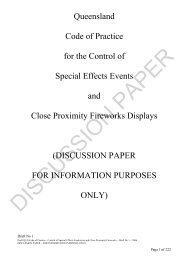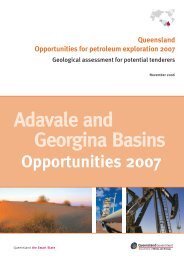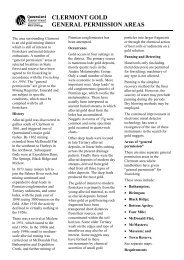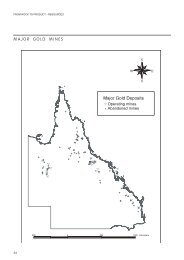Using the Noise Exposure Index as a Risk Ranking Tool
Using the Noise Exposure Index as a Risk Ranking Tool
Using the Noise Exposure Index as a Risk Ranking Tool
You also want an ePaper? Increase the reach of your titles
YUMPU automatically turns print PDFs into web optimized ePapers that Google loves.
<strong>Using</strong> <strong>the</strong> <strong>Noise</strong> <strong>Exposure</strong> <strong>Index</strong> <strong>as</strong> a <strong>Risk</strong><br />
<strong>Ranking</strong> <strong>Tool</strong><br />
Kevin Hedges<br />
Senior Principal Occupational Hygienist (Nor<strong>the</strong>rn Region)
AS1269 “<strong>Noise</strong> Management”<br />
Consists of 5 parts.<br />
Part 0 Overview and general requirements.<br />
Part 1 Me<strong>as</strong>urement and <strong>as</strong>sessment of noise<br />
emissions and exposure.<br />
Part 2 <strong>Noise</strong> control management.<br />
Part 3 Hearing protector program.<br />
Part 4 Auditory <strong>as</strong>sessment.
• In part 2 <strong>the</strong>re is a requirement to rank<br />
exposures so that a priority action<br />
plan can be developed.
Priority should be given to those<br />
noise sources that expose<br />
people to peak noise above<br />
140 dB(C) and to those that<br />
contribute to <strong>the</strong> highest<br />
exposures affecting <strong>the</strong><br />
largest number of people.<br />
NOHSC:2009 (2004)
• The noise exposure index (NEI) is one<br />
tool that will <strong>as</strong>sist in developing a<br />
priority b<strong>as</strong>ed noise abatement plan.
Concept originally developed by Macpherson<br />
J and Tickell C. Development and use of<br />
<strong>Noise</strong> <strong>Exposure</strong> <strong>Index</strong> (NEI) in Occupational<br />
<strong>Noise</strong> Management in proceedings<br />
Australian Acoustical Society. 1996<br />
Conference Brisbane.<br />
Is referenced in AS1269.
The noise exposure index<br />
takes into account <strong>the</strong><br />
number of workers in a<br />
similar exposure group<br />
(SEG).<br />
Presented at AIOH<br />
Conference Albury 1997
N = <strong>the</strong> number of employees exposed in<br />
<strong>the</strong> range of noise level me<strong>as</strong>ured.<br />
CLeq = a risk coefficient for <strong>the</strong> exposure<br />
level range, b<strong>as</strong>ed on <strong>the</strong> calculated<br />
hearing loss for 30 years exposure.
LAeq range Coefficient<br />
70 to 80 dB(A) 0.05<br />
80 to 85 dB(A) 0.1<br />
86 to 90 dB(A) 1.0<br />
91 to 95 dB(A) 2.0<br />
96 to 100 dB(A) 4.0<br />
> 101 dB(A) 5.0
Number of people in similar exposure<br />
group.
SEG LAeqT<br />
dB(A)*<br />
Number C NEI Rank<br />
Jumbo 93 7 2 1302 1<br />
Service 93 7 2 1302 1<br />
Shot<br />
creter<br />
92 4 2 736 2<br />
Loader 86 4 1 344 3<br />
Haul 86 4 1 344 3<br />
Nipper 80 4 0.1 32 4<br />
* Normalised for 8 hours
Shifts 10 hours or greater must be<br />
normalised using <strong>the</strong> following formula:<br />
LAeq, 8h = LAeq, T + 10log10(T/8)<br />
For subsequent shifts <strong>the</strong> following<br />
applies:<br />
9hr to 13hr to 19hr + 2dB<br />
> 18hr to
SEG LAeqT<br />
dB(A)*<br />
Number C NEI Rank<br />
Jumbo 93 7 2 1302 1<br />
Service 93 7 2 1302 1<br />
Shot<br />
creter<br />
92 4 2 736 2<br />
Loader 86 4 1 344 3<br />
Haul 86 4 1 344 3<br />
Nipper 80 4 0.1 32 4<br />
* Normalised for 8 hours
NEI<br />
700<br />
600<br />
500<br />
400<br />
300<br />
200<br />
100<br />
0<br />
<strong>Noise</strong> <strong>Exposure</strong> <strong>Index</strong> (NEI) 2010 - 2014<br />
Jumbo Service prod Haul truck Loader<br />
Similar <strong>Exposure</strong> Group (SEG)<br />
NEI 2010<br />
NEI 2011<br />
NEI 2012<br />
NEI 2013<br />
NEI 2014
After ranking <strong>the</strong> noise exposure index for each<br />
SEG <strong>the</strong> next steps are:<br />
• Evaluation and <strong>as</strong>sessment of <strong>the</strong> noise<br />
control alternatives (engineering and cost).<br />
• <strong>Ranking</strong> priority for <strong>the</strong> noise control plan<br />
actions.<br />
• Activities timing and costs.<br />
• Implementation and ongoing <strong>as</strong>sessment<br />
and monitoring.
SEG LAeqT<br />
dB(A)*<br />
Number C NEI Rank Options $<br />
Jumbo 93 7 2 1302 1<br />
Service 93 7 2 1302 1<br />
Shot<br />
creter<br />
92 4 2 736 2<br />
Loader 86 4 1 344 3<br />
Haul 86 4 1 344 3<br />
Nipper 80 4 0.1 32 4<br />
* Normalised for 8 hours
• The cost to retrofit is 10 - 13 times more<br />
than to establish a buy quiet policy and that<br />
<strong>the</strong> le<strong>as</strong>t expensive noise control is to<br />
relocate.<br />
• Compare people in a noisy factory with<br />
people in an airport standing at a baggage<br />
carousel. It would be more logical if<br />
people can stand away from <strong>the</strong> carousel<br />
and only approach <strong>the</strong> carousel when <strong>the</strong>ir<br />
baggage is available.


